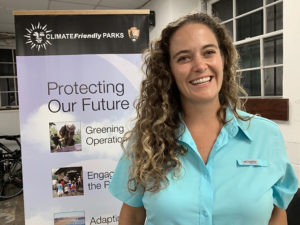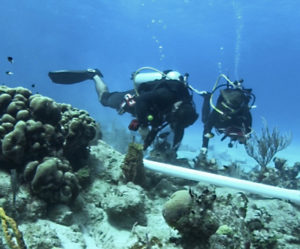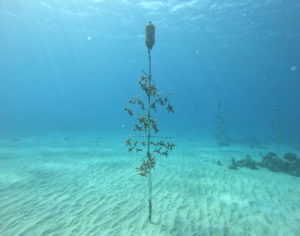
Coral lovers throughout the Caribbean may soon look to St. Croix for solutions to reef degradation.
With coral reefs on the decline in tropical regions worldwide, The Nature Conservancy has established a program to amp-up restoration, conservation, and research in the Caribbean and is making St. Croix a “coral innovation hub.”
Dr. Ashlee Lillis, the Virgin Islands coral manager for The Nature Conservancy, spoke about the program Thursday at the Friends of St. Croix National Parks April lecture. She entitled her talk “Building Resilient Reefs of the Future: Innovative Coral Conservation and Monitoring on St. Croix.”
“We want this innovation hub to be a place where we draw on technology and skills to make an impact,” Lillis said.
A marine scientist from Canada with a background in ecology and oceanography, Lillis moved to the island three months ago and has taken the helm.
Although the project suffered setbacks when Hurricane Maria hit, it is moving forward again.

The coral restoration team uses new strategies and up-to-the-minute technologies. It has installed nurseries at Cane Bay and “Kraken” which is in the East End Marine Park north of Teague Bay. The Cane Bay nursery survived the storm; Kraken is new.
“Coral fragments will be stocked at Kraken starting next week,” Lillis said. “Over the next few weeks, we will continue to add microfragmented corals.”
Microfragmentation, considered a breakthrough technique, accelerates coral growth rates and facilitates reproduction in the nurseries. The team will replant the corals on three reefs around the island.

Meanwhile, The Nature Conservancy is working to complete a land-based facility on its 27-acre nature preserve in Little Princess. As the heart of the coral restoration operations, this facility will have large outdoor tanks that house 30,000 corals per year as well as smaller tanks indoors.
“Coral reefs are the most biodiverse of all marine systems,” Lillis said. “The animals and fish that live in coral reefs all make different sounds.”
It was those sounds that drew Lillis to study the reefs.
“Coral reefs are made of animals, plants, and minerals and support biodiversity,” she said.
She explained that corals are animals closely related to jellyfish and are composed of thousands of polyps that have a symbiotic relationship with algae living in their tissues. They produce a mineral skeleton that builds the structure of reefs.
Coral reefs attract fish, support 25 percent of the ocean’s biodiversity, support tourism, provide shoreline protection, protect land from storm surge and are an economic boon.
“They have dramatically declined over the past decade,” said Lillis. She displayed aerial photos taken in 1975 and again in 2004 to illustrate how long ago coral reef degradation actually began.
Major threats include climate change, pollution, overfishing, human impact and the bleaching that occurs when the polyps expel the algae because of stress caused by heat or pollution.
The project is threefold: coral reef protection, restoration, and monitoring.
Already working with staghorn, elkhorn, and pillar corals, Lillis and her team will add mountainous star coral, boulder star corals, brain corals, lettuce corals and great star corals to the program.
“I can spawn all the coral but we need to know where to put them down,” Lillis said.
Thus, the monitoring. Learning what conditions are most conducive to the different species informs their decisions.
To this end, The Nature Conservancy has partnered with Planet and Carnegie Airborne Observatory to monitor coral systems. Satellites, aerial drones, and boat and diver drones can all provide images that indicate how the coral is faring.
On a local level, The Nature Conservancy coordinates efforts with the Department of Natural Resources and the East End Marine Park, the National Park Service, and with the University of the Virgin Islands.
“We also partner with the Junior Scientists of the Sea and plan to have additional partners moving forward as our efforts expand,” Lillis said.
She would like the kids to steward her nursery programs and welcomes affiliation with coral gardeners, dive shops, scientists, interns and nature lovers.
“It’s important that we engage the community, especially the youth, in order to make the project sustainable. We really need all hands on deck, and we will retrain fishermen,” she said.
In partnership with the East End Marine Park and as part of its Coral Reef Conservation program grant from NOAA, The Nature Conservancy has built a demonstration coral nursery at Cramer’s Park. Lillis said that snorkelers “may come across an underwater table with coral colonies growing on it!”
As St. Croix takes the lead in innovative coral restoration work, The Nature Conservancy collaborates with other islands in the region. The Dominican Republic and the Bahamas are also hubs for coral propagation and conservation.
“The fish don’t care about geographic boundaries, and neither should we,” Lillis said.





